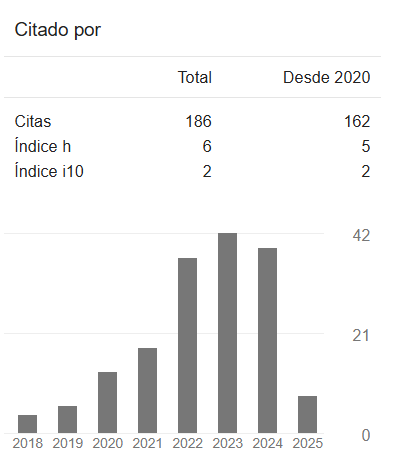Public security beyond repression
The role of the Cities of Care in overcoming exclusion
DOI:
https://doi.org/10.35305/23626097v12i22.508Keywords:
cities of care, social urbanism, social vulnerability, public security, neoliberalismAbstract
The article analyzes the impact of neoliberalism on public safety and on the urban configuration of Latin America, highlighting the increase in inequality and the criminalization of poverty. The retraction of the State in the provision of social welfare has intensified socio-spatial fragmentation and strengthened the logic of security based on repression and mass incarceration, especially in urban peripheries. In contrast, the text presents the concept of “Cities of Care” as an alternative to the punitive model, emphasizing citizen security, social inclusion and urban infrastructures oriented towards collective well-being. A concrete example of this approach is Recife's COMPAZ Program, which seeks to promote security by offering educational, cultural and social services in vulnerable areas. Community Peace Centers - COMPAZ - demonstrate how the presence of the State can be reformulated to reinforce community ties and reduce violence without resorting to repression. The COMPAZ experience illustrates the viability of social urban planning as a public security strategy, reaffirming the need for policies based on care and citizenship to build fairer and safer cities.
Downloads
Metrics
References
Caldeira, T. (2003). Cidade de muros: crime, segregação e cidadania em São Paulo. São Paulo, Brasil: Editora 34.
Cunha, F. y Cardoso, C. (Org.) (2022). Compaz Espaço de Inclusão e Transformação Social - Política Pública de Prevenção à Violência da Cidade do Recife. Traducción: Peter Ratcliffe; prefacio: João Campos. Recife, Brasil: Cepe. Recuperado de https://acervocepe.com.br/public/pdfs/COMPAZ.pdf.
Davis, M. (2006). Planeta Favela. São Paulo, Brasil: Boitempo.
Diniz Moreira, F. (2023). Creando urbanidad a través del vacío: los complejos COMPAZ en Recife, 2016-2021. A&P Continuidad, 10(19), 62-75. doi: https://doi.org/10.35305/23626097v10i19.422
Echeverri, A. y Orsini, C. (2010). Urbanismo Social en Medellín: Innovación y Transformación de la Ciudad. Barcelona, España: Actar Publishers.
Fisher, B. y Tronto, J. (1990). Toward a Feminist Theory of Care. En E. Abel y M. Nelson, (Eds.), Circles of Care: Work and Identity in Women's Lives (pp.35-62). Albany, USA: State University of New York Press.
Harvey, D. (2005). O neoliberalismo: história e implicações. São Paulo, Brasil: Loyola.
Instituto Brasileiro de Geografia e Estatística (IBGE) (2022). Pesquisa Nacional por Amostra de Domicílios. Recuperado de https://www.ibge.gov.br/estatisticas/sociais/populacao/9127-pesquisa-nacional-por-amostra-de-domicilios.html
Limeira, J. V. (2022). COMPAZ–política pública de redução da violência através da promoção da cidadania: análise teórica e prática sob uma perspectiva jurídica (Tesis de maestría). Instituto Brasileiro Ensino, Desenvolvimento e Pesquisa – IDP, Brasil. Recuperado de http://52.186.153.119/bitstream/123456789/4235/1/DISSERTA%C3%87%C3%83O_JULIANA%20VILLAR%20LIMEIRA_MESTRADO%20DIREITO.pdf
Nogueira, A. (2019). Da cidade democrática à cidade mercadoria: a trajetória institucional das Políticas Urbanas de Recife, PE. En Anais XVIII ENANPUR 2019. Recuperado de https://xviiienanpur.anpur.org.br/anaisadmin/capapdf.php?reqid=1277.
ONU. (2022). Prêmio de Serviço Público das Nações Unidas – COMPAZ Recife. Recuperado de https://publicadministration.un.org/unpsa/database/Winners/2022-winners/Community-Peace-Center.
Ostrom, E. (2009). Governing the Commons: The Evolution of Institutions for Collective Action. Cambridge, USA: Cambridge University Press.
Ponzi, T. y Leite, C. (2021). Urbanismo social com as cores do recife. Revista Piauí, 1-3.
Prefeitura do Recife, (sin fecha, b). Plano Municipal de Segurança Urbana e Prevenção da Violência. Recife: Prefeitura do Recife. Recuperado de https://www2.recife.pe.gov.br/sites/default/files/pactopelavida.pdf
Prefeitura do Recife. (2024). Conheça o Compaz: fábrica de cidadania do Recife. Recuperado de https://www2.recife.pe.gov.br.
Prefeitura do Recife. Núcleo de Avaliação de Políticas Públicas e Ciência de Dados. (sin fecha a). COMPAZ – Avaliação Executiva. Recife: Prefeitura do Recife. Recuperado de https://oecd-opsi.org/wp-content/uploads/2023/08/00636_01_apresentacao-avaliacao-executiva-compaz-1.pdf
Rêgo, R. R. S. (2018). Política Pública e Redução da Criminalidade Urbana: Uma análise empírica do Compaz em bairros do Recife (Tesis de maestria). UFPE, Brasil. Recuperado de https://bdtd.ibict.br/vufind/Record/UFPE_1bbd3e86d05ceefe80c246f34e2297b6
Ribeiro, L. y Ribeiro, M. (Org.) (2013). IBEU. Índice de Bem-estar Urbano. Rio de Janeiro: Observatório das Metrópoles / Letra Capital. Recuperado de https://ibeu.observatoriodasmetropoles.net.br/wp-content/uploads/2019/05/Indice_de_bem-estar_urbano.pdf
Rolnik, R. (2019). Guerra dos lugares: a colonização da terra e da moradia na era das finanças. São Paulo, Brasil: Boitempo.
Tronto, J. C. (1998). An ethic of care. Generations. Journal of the American society on Aging, 22(3), 15-20.
UNICEF. (2023). Estudo sobre o impacto dos Centros Comunitários da Paz (COMPAZ) como estratégia de segurança cidadã e desenvolvimento juvenil. Recuperado de https://www.unicef.org/brazil/comunicados-de-imprensa/unicef-e-prefeitura-do-recife-apresentam-estudo-sobre-o-compaz.
Waquant, L. (2009). Punir os Pobres: a nova gestão da miséria nos Estados Unidos. Rio de Janeiro, Brasil: Revan.
West, R. (1996). Justice and Care: Essential Readings in Feminist Ethics. Boulder, USA: Westview Press.
Yin, R. K. (2015). Estudo de Caso-: Planejamento e métodos. Porto Alegre: Bookman editora.

Published
How to Cite
Issue
Section
License
Copyright (c) 2025 A&P Continuidad

This work is licensed under a Creative Commons Attribution-NonCommercial-ShareAlike 4.0 International License.
Open access policy
A&P Continuidad is a non-profit and open access publication. According to Mexico Declaration on Cultural Policies, the journal distribution is submitted to Creative Commons Attribution-Noncommercial-ShareAlike 4.0 International Public License (CC BY-NC-SA). “Neither the commercial use of the original work nor that of the possible derivative works are allowed. The distribution of derivative works should be submitted to the license regulating the original work. This license is not free.”
A&P Continuidad authorizes the partial or full reproduction of texts and graphs provided that the source is cited. Authors are exclusively responsible for the criteria expressed in the articles which do not necessarily reflect the opinion of the Editorial Committee or that of the Direction Board. The copyright of the published articles pertains to their authors or publishers.
Transfer of rights
The acceptance of an article to be published implies the author’s transfer of rights to the journal. Authors continue to have the right to use the material in future books or publications, approve or veto the republication of their works as well as the rights related to patents or other rights. Transfer of rights form may be downloaded here.





























 This OJS site and its metadata are under a
This OJS site and its metadata are under a 

